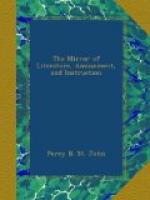Returning to the verge of the hill, you soon reach the apex, or highest point, being 445 feet from the level of the Mole.[1] Here you enjoy what the French call a coup d’oeil, or I would rather say, a bird’s-eye view, of unparalleled beauty. Taking the town of Dorking for a resting point, the long belt is about twelve miles in extent. The outline or boundary commences from the eminence on which I am supposed to be standing—with Brockham Hill, whose steep was planted by the late duke of Norfolk, and whence the chain extends away towards the great Brighton road. Next in the curve are Betchworth Castle and Park, with majestic avenues of limes and elms, and fine old chestnut-trees. Adjoining, is the Deepdene, the classical seat of the author of “Anastasius,” a place, says Salmon, “well calculated for the religious rites of the Celts,” and consecrated by the philosophical pursuits of the Hon. Charles Howard, who built an oratory and laboratory, and died here in 1714. Next are several fir-crowned ridges, which shelter Bury Hill, the mansion of Mr. Barclay, the opulent brewer; whence you ascend the opposite line of hills, till you reach Denbies, nearly facing the most prominent point of Box Hill. This elegant seat is the abode of Mr. Denison, one of the county members, and brother of the Marchioness of Conyngham. The second range or ledge, beneath Denbies, is the celebrated Dorking lime-works. The transition to the Norbury Hills, already mentioned, is now very short, which completes the outline of the view. It should, however, be remarked that the scenery within this range can be distinctly enjoyed without the aid of art; whilst beyond it the prospect extends, and fades away in the South Downs on one hand, and beyond the metropolis on the other.
The little parterre to be described, includes the sheltered town of Dorking, environed with rich lawny slopes, variegated with villas in the last taste; and little heights, from whose clustering foliage peeps the cottage roof of humble life. But the Paradise immediately at the foot of Box Hill is the gem of the whole scene, and is one of the most perfect pictures of rural beauty which pen or pencil can attempt. It appears like an assemblage of every rural charm in a few acres, in whose disposal nature has done much, and art but little. Park, lawn, woody walk, slope, wilderness and dell are among its varieties; and its quiet is only broken by the sluggish stream of the Mole. Adjoining is a little inn, more like one of the picturesque auberges of the continent than an English house of cheer. The grounds are ornamented with rustic alcoves, boscages, and a bowery walk, all in good taste. Here hundreds of tourists pass a portion of “the season,” as in a “loop-hole of retreat.” In the front of the inn, however, the stream of life glides fast; and a little past it, the road crosses the Mole by Burford Bridge, and winds with geometrical accuracy through the whole of this hasty sketch.




